Directional Hydraulic Fracturing (DHF) of the Roof, as an Element of Rock Burst Prevention in the Light of Underground Observations and Numerical Modelling
Abstract
1. Introduction
- —rock mass pressure based on the depth, exploitation events, geological disturbances,
- —tension strength of rocks in the plane of the created fracture
2. Examples of Using Directional Hydraulic Fracturing of the Roof at PGG S.A. Unit KWK ROW Ruch Rydultowy Coal Mine Within Longwall II-E1, Coal Seam 713/1-2
- Compressive strength of roof rocks: 40.9: 79.0 MPa
- Compressive strength of floor rocks: 38.4: 48.0 MPa
- Compressive strength of coal in seam 713/1-2: 14.20 MPa.
- The number of shocks for each row from 102–108 J
- The monthly number of shocks
- Monthly summary energy
- Monthly summary energy divided by the monthly production volume
- Maximum energy of a single shock
- The maximum daily progress during the start-up period was 4 m per day, and on the remaining length it was 6 m per day.
- Areas of specific risk of rock bursts have been designated: in longwall galleries, i.e., gallery 1a-E1 and 2-E1, as well as on sections of wall II-E1 with individual support.
- Constant seismological observation was carried out.
- Seismic and acoustic observation was carried out using two geophones fitted into the longwall galleries before the face of the wall.
- Each day, small-diameter survey drillings were performed: in three measuring belts in the wall and in two measuring belts in longwall galleries (15 m and 30 m before the face of the wall).
3. Analyzing the Behavior of the Rock Mass Subjected to Hydraulic Fracturing Based on Numerical Modeling
- Stiffness in normal direction—108 GPa/m
- Shear stiffness—43 GPa/m
- Cohesion—0,8 MPa
- Tensile strength—0,2 MPa
- Friction angle—30°
- Dilatation angle—0°
- —shear stress
- —limit value of shear stress
- C—Cohesion
- —friction angle
- —kinetic energy of all gridpoints
- —mass of grid point i
- —velocity at grid point i
- —number of grid points
4. Summary and Conclusions
Author Contributions
Funding
Institutional Review Board Statement
Informed Consent Statement
Data Availability Statement
Conflicts of Interest
References
- Montgomery, C.T.; Smith, M.B. Hydraulic Fracturing: History of an Enduring Technology. J. Pet. Technol. 2010, 62, 26–40. [Google Scholar] [CrossRef]
- Gandossi, L. An Overview of Hydraulic Fracturing and Other Formation Stimulation Technologies for Shale Gas Production; Scientific and Policy Report by the Joint Research Centre of the European Commission, Publications Office of the European Union: Luxembourg, 2013. [Google Scholar]
- Gandossi, L.; Von Estorff, U. An Overview of Hydraulic Fracturing and Other Formation Stimulation Technologies for Shale Gas Production—Update 2015; Science for Policy report by the Joint Research Centre, Joint Research Centre of the European Commission, Technical Report, Publications Office of the European Union: Luxembourg, 2015. [Google Scholar]
- Liew, M.S.; Danyaro, K.U.; Zawawi, N.A.W.A. A Comprehensive Guide to Different Fracturing Technologies: A Review. Energies 2020, 13, 3326. [Google Scholar] [CrossRef]
- Kabiesz, J.; Lurka, A.; Drzewiecki, J. Selected Methods of Rock Structure Disintegration to Control Mining Hazards Wybrane Metody Dezintegracji Struktury Skał Dla Zwalczania Zagrożeń Górniczych. Arch. Min. Sci. 2015, 60, 807–824. [Google Scholar] [CrossRef]
- Liu, J.; Liu, C.; Li, X. Determination of fracture location of double-sided directional fracturing pressure relief for hard roof of large upper goaf-side coal pillars. Energy Explor. Exploit. 2020, 38, 111–136. [Google Scholar] [CrossRef]
- Frejowski, A.; Myszkowski, J. Możliwości wykorzystania metody ukierunkowanego hydroszczelinowania skał (UHS) do odmetanowania górotworu karbońskiego w warunkach GZW. Prace Naukowe GIG. Górnictwo i Środowisko 2009, 4, 74–82. [Google Scholar]
- Fan, J.; Dou, L.; He, H.; Du, T.; Zhang, S.; Gui, B.; Sun, X. Directional hydraulic fracturing to control hard-roof rockburst in coal mines. Int. J. Min. Sci. Technol. 2012, 22, 177–181. [Google Scholar] [CrossRef]
- Haimson, B. Deep in-Situ Stress Measurements by Hydrofracturing. Dev. Geotecton. 1975, 9, 41–47. [Google Scholar]
- Cornet, F.H.; Valette, B. In Situ Stress Determination from Hydraulic Injection Test Data. J. Geophys. Res. 1984, 89, 11527–11537. [Google Scholar] [CrossRef]
- Makówka, J. Method of Determining the Triaxial Stress State in the Rock Mass with Directed Hydrofracturing/Metoda Określania Trójosiowego Stanu Naprężenia W Górotworze Z Użyciem Ukierunkowanego Hydroszczelinowania. Arch. Min. Sci. 2015, 60, 729–741. [Google Scholar] [CrossRef]
- Patyńska, R.; Kabiesz, J. Scale of seismic and rock burst hazard in the Silesian companies in Poland. Min. Sci. Technol. 2009, 19, 604–608. [Google Scholar]
- Mutke, G.; Dubiński, J.; Lurka, A. New Criteria to Assess Seismic and Rock Burst Hazard in Coal Mines / Nowe Kryteria Dla Oceny Zagrożenia Sejsmicznego I Tąpaniami W Kopalniach Węgla Kamiennego. Arch. Min. Sci. 2015, 60, 743–760. [Google Scholar] [CrossRef]
- Liu, X.; Liu, Q.; Liu, B.; Kang, Y. A Modified Bursting Energy Index for Evaluating Coal Burst Proneness and Its Application in Ordos Coalfield, China. Energies 2020, 13, 1729. [Google Scholar] [CrossRef]
- Mark, C. Coal bursts in the deep longwall mines of the United States. Int. J. Coal Sci. Technol. 2016, 3, 1–9. [Google Scholar] [CrossRef]
- Dou, L.-M.; Mu, Z.-L.; Li, Z.-L.; Cao, A.-Y.; Gong, S. Research progress of monitoring, forecasting, and prevention of rockburst in underground coal mining in China. Int. J. Coal Sci. Technol. 2014, 1, 278–288. [Google Scholar] [CrossRef]
- Keneti, A.; Sainsbury, B.-A.L. Review of published rockburst events and their contributing factors. Eng. Geol. 2018, 246, 361–373. [Google Scholar] [CrossRef]
- Li, C.C.; Mikula, P.; Simser, B.; Hebblewhite, B.; Joughin, W.; Feng, X.; Xu, N. Discussions on rockburst and dynamic ground support in deep mines. J. Rock Mech. Geotech. Eng. 2019, 11, 1110–1118. [Google Scholar] [CrossRef]
- Konopko, W.; Myszkowski, J. Wyprzedzająca aktywna profilaktyka tąpaniowa. Przegląd Górniczy 2005, 61, 33–38. [Google Scholar]
- Myszkowski, J. Metoda ukierunkowanego szczelinowania skał. Część 3, Zasady projektowania ukierunkowanego szczelinowania. Przegląd Górniczy 2007, 63, 21–25. [Google Scholar]
- Konopko, W.; Kabiesz, J.; Merta, G.; Makówka, J. Ukierunkowane hydroszczelinowanie skał i kierunki jego wykorzystania. Prace Naukowe Głównego Instytutu Górnictwa 1997, 824, 1–33. [Google Scholar]
- Myszkowski, J.; Makówka, J.; Merta, G. Ukierunkowane hydroszczelinowanie skał - nowe rozwiązania i zastosowania. Przegląd Górniczy 2019, 75, 43–50. [Google Scholar]
- Konopko, W. Ukierunkowane hydroszczelinowanie skał (UHS). Przegląd Górniczy 1991, 6, 1–8. [Google Scholar]
- Tajduś, A.; Cała, M.; Tajduś, K. Seismicity and rock burst hazard assessment in fault zones: A case study. Arch. Min. Sci. 2018, 63, 747–765. [Google Scholar]
- He, M.; Zhang, X.; Zhao, S. Directional Destress with Tension Blasting in Coal Mines. Procedia Eng. 2017, 191, 89–97. [Google Scholar] [CrossRef]
- Yang, X.; Liu, C.; Ji, Y.; Zhang, X.; Wang, S. Research on Roof Cutting and Pressure Releasing Technology of Directional Fracture Blasting in Dynamic Pressure Roadway. Geotech. Geol. Eng. 2018, 37, 1555–1567. [Google Scholar] [CrossRef]
- Myszkowski, J. Metoda ukierunkowanego szczelinowania skał. Część 1, Istota metody i badania laboratoryjne jej skuteczności. Przegląd Górniczy 2007, 63, 11–16. [Google Scholar]
- Deng, J.; Lin, C.; Yang, Q.; Liu, Y.; Tao, Z.; Duan, H. Investigation of directional hydraulic fracturing based on true tri-axial experiment and finite element modeling. Comput. Geotech. 2016, 75, 28–47. [Google Scholar] [CrossRef]
- Dubiński, J.; Konopko, W. Tąpania, ocena, prognoza, zwalczanie, 1st ed.; Główny Instytut Górnictwa: Katowice, Poland, 2000; pp. 345–350. [Google Scholar]
- He, H.; Dou, L.; Fan, J.; Du, T.; Sun, X. Deep-hole directional fracturing of thick hard roof for rockburst prevention. Tunn. Undergr. Space Technol. 2012, 32, 34–43. [Google Scholar] [CrossRef]
- Huang, B.; Liu, J.; Zhang, Q. The reasonable breaking location of overhanging hard roof for directional hydraulic fracturing to control strong strata behaviors of gob-side entry. Int. J. Rock Mech. Min. Sci. 2018, 103, 1–11. [Google Scholar] [CrossRef]
- Huang, B.; Zhao, X.; Ma, J.; Sun, T. Field Experiment of Destress Hydraulic Fracturing for Controlling the Large Deformation of the Dynamic Pressure Entry Heading Adjacent to the Advancing Longwall Face. Arch. Min. Sci. 2019, 64, 829–848. [Google Scholar]
- UDEC—Universal Distinct Element Code, Version 4.0. User’s Manual, 2nd ed.; Itasca Consulting Group, Inc.: Minneapolis, MI, USA, 2005.
- Majchrczyk, T.; Niedbalski, Z.; Małkowski, P. Wzmacnianie obudowy wyrobisk korytarzowych w złożonych warunkach górniczo-geologicznych. Górnictwo i Geoinżynieria 2010, 34, 451–462. [Google Scholar]
- Sun, Y.; Li, G.; Zhang, J.; Xu, J. Failure Mechanisms of Rheological Coal Roadway. Sustainability 2020, 12, 2885. [Google Scholar] [CrossRef]
- Wesołowski, M. Numerical Modeling of Exploitation Relics and Faults Influence on Rock Mass Deformations. Arch. Min. Sci. 2016, 61, 893–906. [Google Scholar] [CrossRef][Green Version]
- Wang, J.; Qiu, P.; Ning, J.; Zhuang, L.; Yang, S. A numerical study of the mining-induced energy redistribution in a coal seam adjacent to an extracted coal panel during longwall face mining: A case study. Energy Sci. Eng. 2019, 8, 817–835. [Google Scholar] [CrossRef]
- Yasitli, N.E.; Unver, B. 3D numerical modeling of longwall mining with top-coal caving. Int. J. Rock Mech. Min. Sci. 2005, 42, 219–235. [Google Scholar] [CrossRef]
- Das, R.; Singh, P.K.; Kainthola, A.; Panthee, S.; Singh, T.N. Numerical analysis of surface subsidence in asymmetric parallel highway tunnels. J. Rock Mech. Geotech. Eng. 2017, 9, 170–179. [Google Scholar] [CrossRef]
- Kwaśniewski, M. Numerical analysis of strata behavior in the vicinity of a longwall panel in a coal seam mined with roof caving. In Continuum and Distinct Element Numerical Modeling in Geo-Engineering, Proceedings of 1st International FLAC/DEM Symposium, Minneapolis, MI, USA, August 2008; Hart, R.D., Detournay, C., Cundall, P., Eds.; Itasca Consulting Group Inc.: Minneapolis, MI, USA, 2008; paper no. 07-08; pp. 1–8. [Google Scholar]
- Gao, F.; Stead, D.; Coggan, J. Evaluation of coal longwall caving characteristics using an innovative UDEC Trigon approach. Comput. Geotech. 2014, 55, 448–460. [Google Scholar] [CrossRef]
- Le, T.D.; Oh, J.; Hebblewhite, B.; Zhang, C.; Mitra, R. A discontinuum modelling approach for investigation of Longwall Top Coal Caving mechanisms. Int. J. Rock Mech. Min. Sci. 2018, 106, 84–95. [Google Scholar] [CrossRef]
- Cao, J.; Dou, L.; Zhu, G.; He, J.; Wang, S.; Zhou, K. Mechanisms of Rock Burst in Horizontal Section Mining of a Steeply Inclined Extra-Thick Coal Seam and Prevention Technology. Energies 2020, 13, 6043. [Google Scholar] [CrossRef]
- Makówka, J. Analiza numeryczna przestrzennego rozkładu stanu naprężenia w otoczeniu typowych układów krawędzi eksploatacji zawałowej za pomocą metody elementów odrębnych. Przegląd Górniczy 2010, 6, 165–179. [Google Scholar]
- Politechnika Śląska, B.J.; Mielimąka, R.; Sokoła-Szewioła, V.; Wesołowski, M. Metoda numerycznego modelowania wpływu kolejności i kierunku eksploatacji na deformacje terenu górniczego, 1st ed.; Publishing House of the Silesian University of Technology: Gliwice, Poland, 2015; Volume 1, pp. 46–74. [Google Scholar]
- Vakili, A.; Hebblewhite, B.K. A new cavability assessment criterion for Longwall Top Coal Caving. Int. J. Rock Mech. Min. Sci. 2010, 47, 1317–1329. [Google Scholar] [CrossRef]
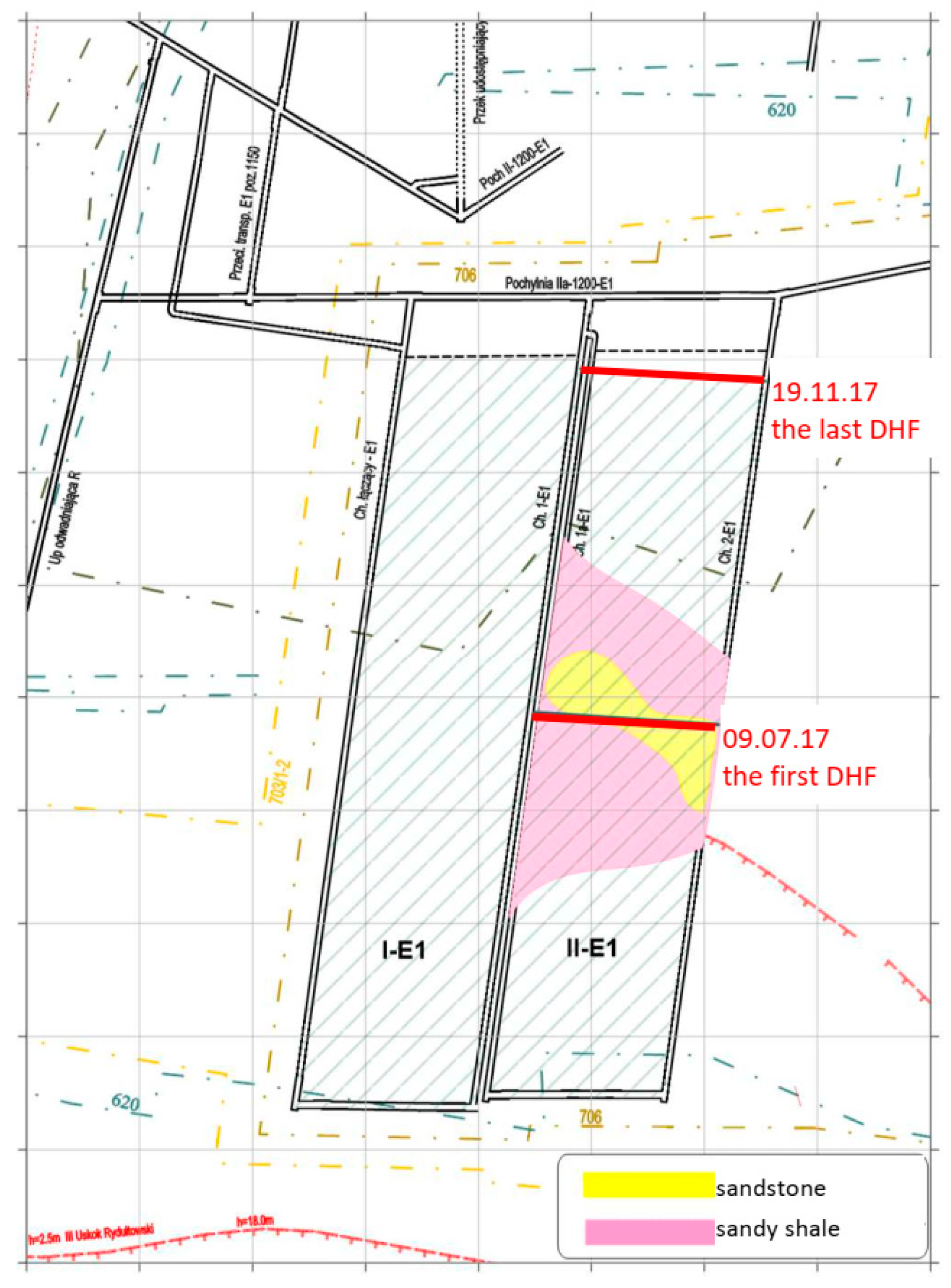
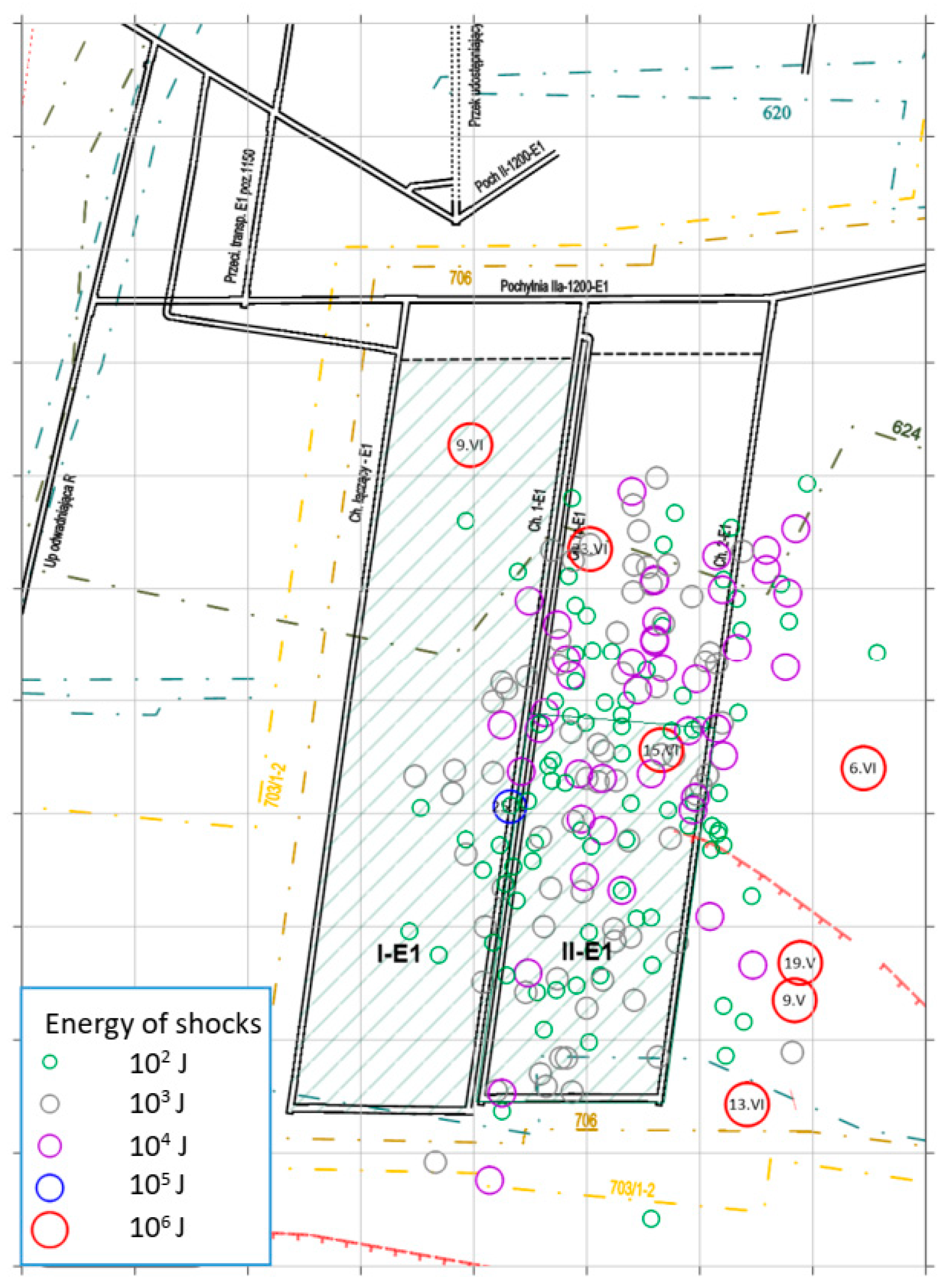
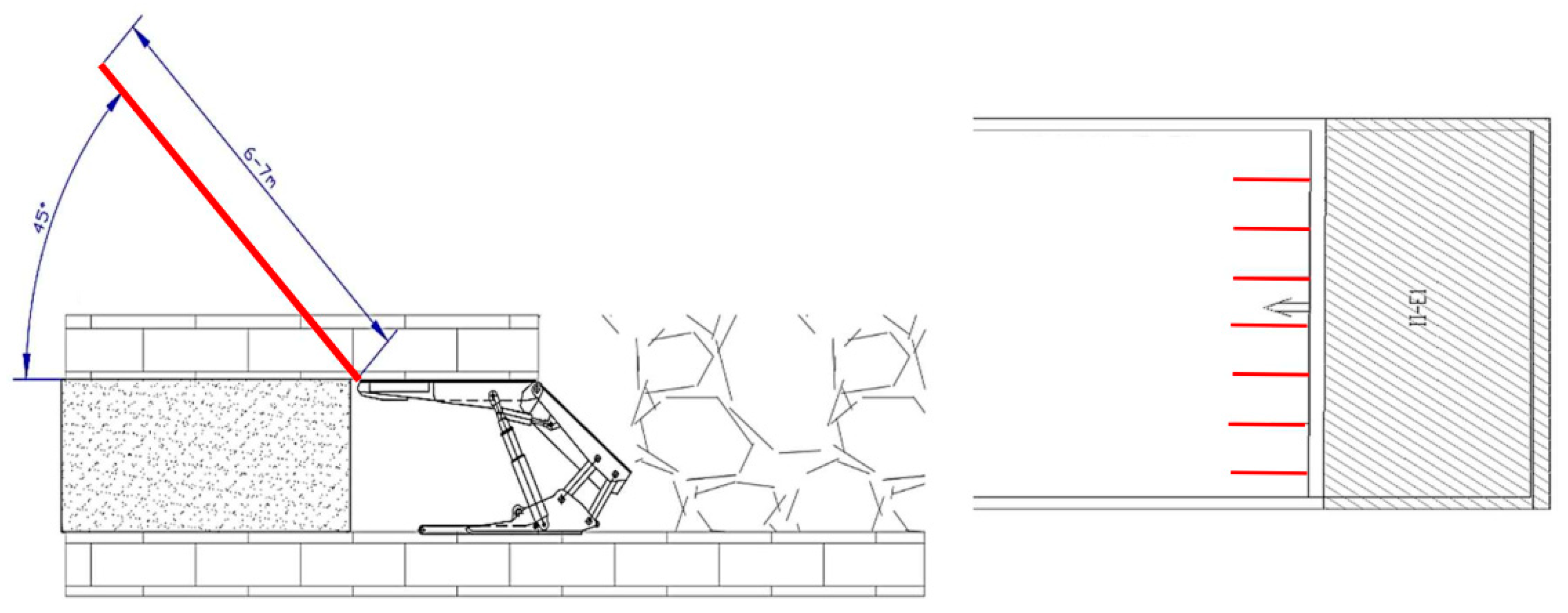
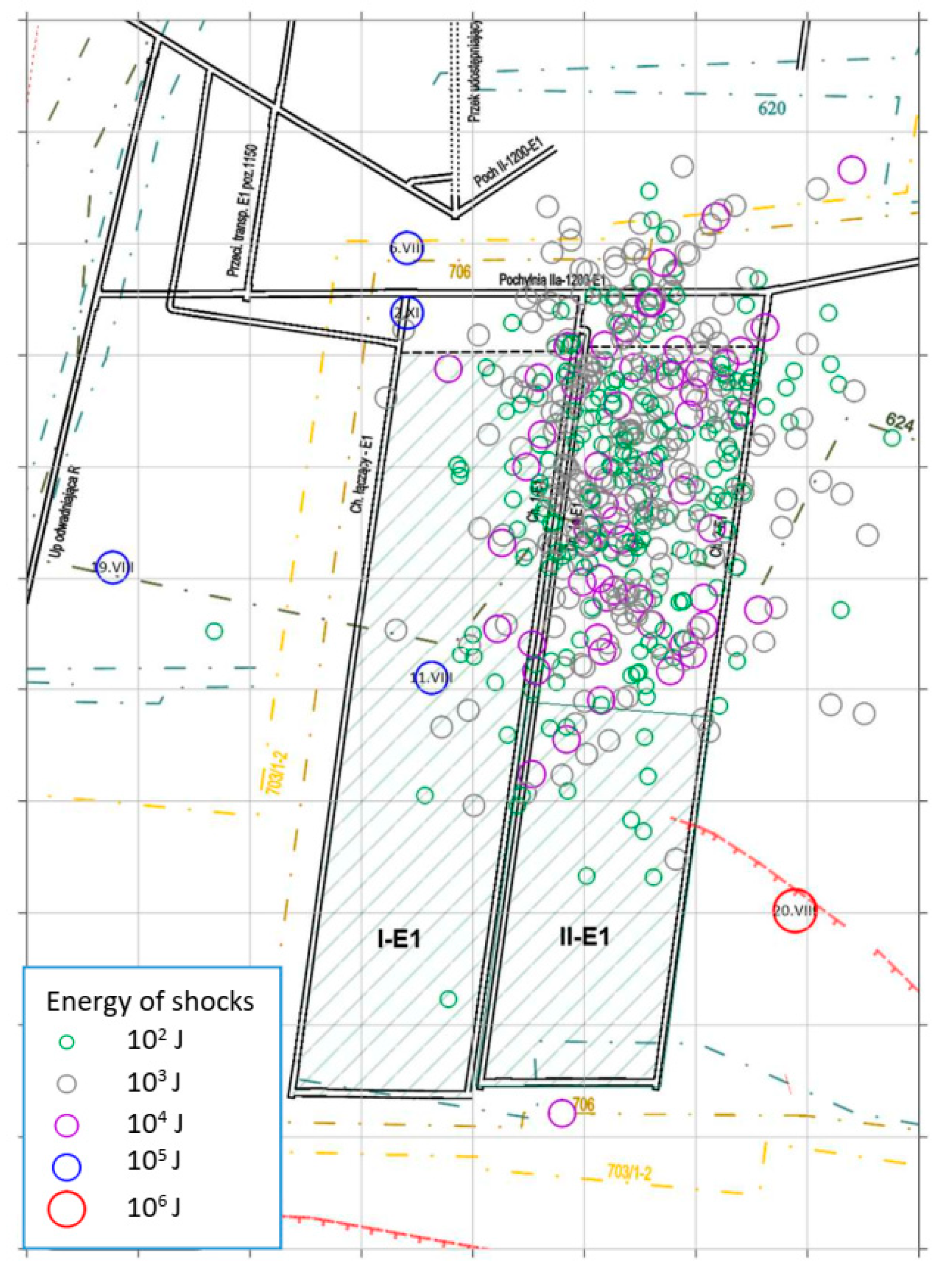




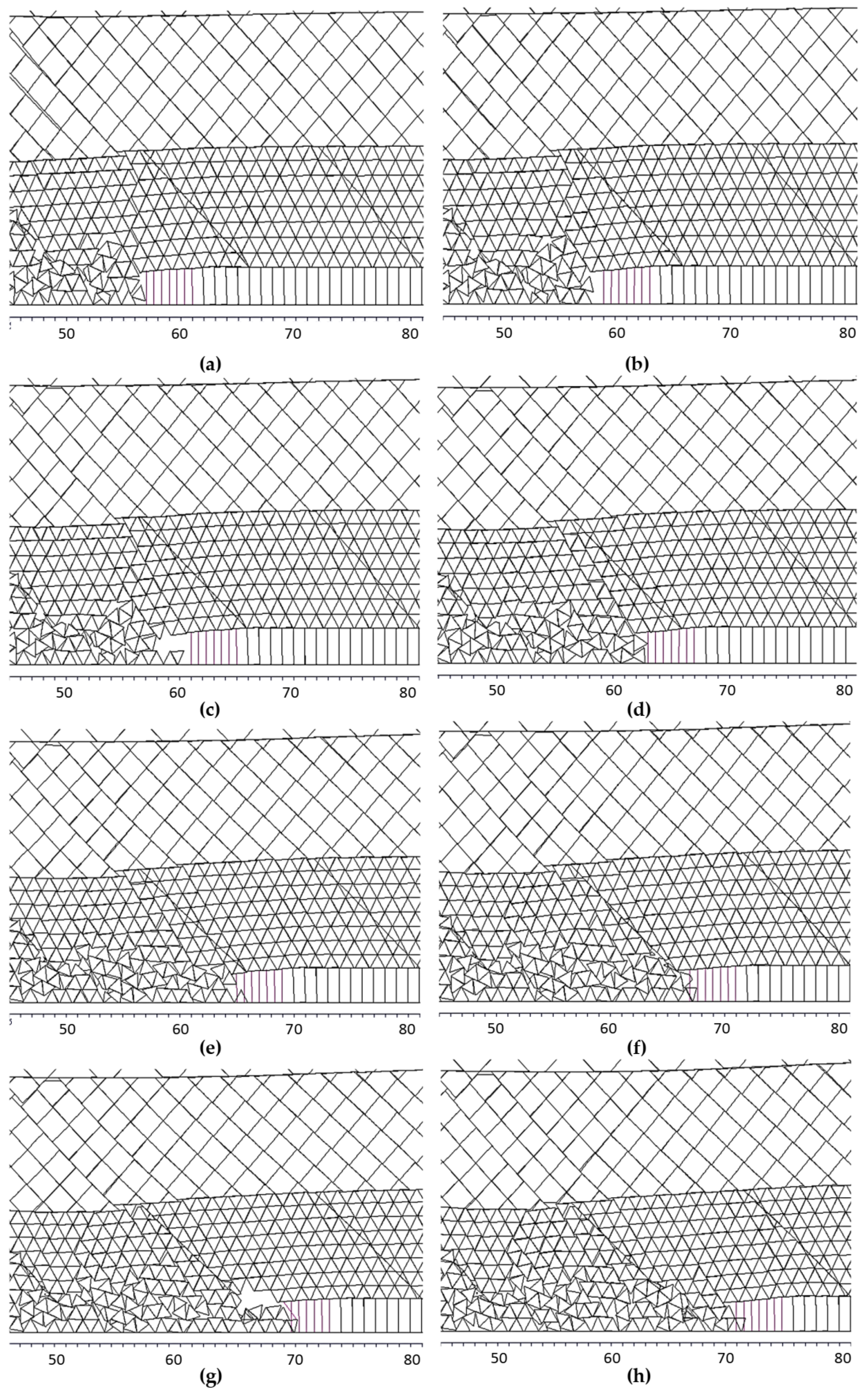

| Month | Monthly Progress, m | Length Left, m | Number of Shocks of Energy: | Monthly Summary Energy, J | I = E/W, J/t | E Max, J | E/Progress, J/m | |||||||
|---|---|---|---|---|---|---|---|---|---|---|---|---|---|---|
| 102 J | 103 J | 104 J | 105 J | 106 J | 107 J | 108 J | Total | |||||||
| II | 10.3 | 578 | 0 | 0 | 0 | 0 | 0 | 0 | 0 | 0 | 0.0 × 100 | 0.0 | 0.0 × 100 | 0.0 × 100 |
| III | 92.3 | 568 | 1 | 0 | 0 | 0 | 0 | 0 | 0 | 1 | 6.3 × 102 | 0.0 | 6.3 × 102 | 6.8 × 100 |
| IV | 78.3 | 492 | 4 | 0 | 1 | 0 | 0 | 0 | 0 | 5 | 1.8 × 104 | 0.5 | 1.5 × 104 | 2.3 × 102 |
| V | 51.3 | 438 | 0 | 1 | 0 | 0 | 0 | 0 | 0 | 1 | 1.3 × 103 | 0.0 | 1.3 × 103 | 2.5 × 101 |
| VI | 58.5 | 383 | 5 | 2 | 1 | 1 | 0 | 0 | 0 | 9 | 2.5 × 105 | 6.0 | 1.6 × 105 | 4.3 × 103 |
| VII | 104.3 | 279 | 7 | 5 | 1 | 0 | 2 | 0 | 0 | 15 | 3.2 × 106 | 45.2 | 1.9 × 106 | 3.1 × 104 |
| VIII | 71.0 | 210 | 13 | 28 | 4 | 0 | 0 | 0 | 0 | 45 | 1.5 × 105 | 3.3 | 3.1 × 104 | 2.1 × 103 |
| IX | 74.5 | 136 | 8 | 16 | 2 | 0 | 0 | 1 | 0 | 27 | 2.0 × 107 | 399.3 | 2.0 × 107 | 2.7 × 105 |
| X | 92.0 | 44 | 0 | 5 | 1 | 1 | 0 | 0 | 0 | 7 | 4.2 × 105 | 7.8 | 3.1 × 105 | 4.6 × 103 |
| XI | 43.0 | 1 | 1 | 0 | 0 | 1 | 0 | 0 | 0 | 2 | 2.9 × 105 | 0.0 | 2.9 × 105 | 6.7 × 103 |
| Total: | 39 | 57 | 10 | 3 | 2 | 1 | 0 | 112 | 2.4 × 107 | - | 2.0 × 107 | - | ||
| Month | Monthly Progress, m | Length Left, m | Number of Shocks of Energy: | Monthly Summary Energy, J | I = E/W, J/t | E Max, J | E/Progress, J/m | |||||||
|---|---|---|---|---|---|---|---|---|---|---|---|---|---|---|
| 102 J | 103 J | 104 J | 105 J | 106 J | 107 J | 108 J | Total | |||||||
| III | 16.3 | 646 | 1 | 0 | 0 | 0 | 0 | 0 | 0 | 1 | 6.7 × 102 | 0.1 | 6.7 × 102 | 4.1 × 101 |
| IV | 93.5 | 552 | 3 | 9 | 0 | 1 | 0 | 0 | 0 | 13 | 2.6 × 105 | 4.8 | 8.5 × 103 | 2.8 × 103 |
| V | 123.0 | 429 | 42 | 23 | 10 | 0 | 2 | 0 | 0 | 77 | 6.8 × 106 | 71.9 | 3.4 × 106 | 5.5 × 104 |
| VI | 111.8 | 318 | 28 | 32 | 24 | 0 | 5 | 0 | 0 | 89 | 2.0 × 107 | 279.3 | 7.9 × 106 | 1.8 × 105 |
| VII | 58.5 | 259 | 13 | 10 | 9 | 0 | 0 | 0 | 0 | 32 | 4.3 × 105 | 23.3 | 9.0 × 104 | 1.5 × 104 |
| Total: | 87 | 74 | 43 | 1 | 7 | 0 | 0 | 212 | 2.7 × 107 | - | 1.2 × 107 | - | ||
| Month | Monthly Progress, m | Length Left, m | Number of Shocks of Energy: | Monthly Summary Energy, J | I = E/W, J/t | E Max, J | E/Progress, J/m | |||||||
|---|---|---|---|---|---|---|---|---|---|---|---|---|---|---|
| 102 J | 103 J | 104 J | 105 J | 106 J | 107 J | 108 J | Total | |||||||
| VII | 58.5 | 259 | 26 | 29 | 11 | 0 | 0 | 0 | 0 | 66 | 8.6 × 105 | 23.3 | 9.0 × 104 | 1.5 × 104 |
| VIII | 70 | 189 | 51 | 50 | 17 | 3 | 1 | 0 | 0 | 122 | 4.2 × 106 | 72.1 | 3.3 × 105 | 6.0 × 104 |
| IX | 76 | 113 | 68 | 98 | 13 | 0 | 0 | 0 | 0 | 179 | 6.6 × 105 | 15.0 | 3.3 × 104 | 8.7 × 103 |
| X | 73.25 | 39.75 | 30 | 69 | 14 | 0 | 0 | 0 | 0 | 113 | 4.9 × 105 | 12.0 | 6.2 × 104 | 6.7 × 103 |
| XI | 40 | −0.25 | 16 | 20 | 1 | 1 | 0 | 0 | 0 | 38 | 8.9 × 105 | 31.1 | 3.1 × 105 | 2.2 × 104 |
| Total: | 191 | 266 | 56 | 4 | 1 | 0 | 0 | 518 | 7.10 × 106 | - | 1.2 × 107 | - | ||
Publisher’s Note: MDPI stays neutral with regard to jurisdictional claims in published maps and institutional affiliations. |
© 2021 by the authors. Licensee MDPI, Basel, Switzerland. This article is an open access article distributed under the terms and conditions of the Creative Commons Attribution (CC BY) license (http://creativecommons.org/licenses/by/4.0/).
Share and Cite
Jendryś, M.; Hadam, A.; Ćwiękała, M. Directional Hydraulic Fracturing (DHF) of the Roof, as an Element of Rock Burst Prevention in the Light of Underground Observations and Numerical Modelling. Energies 2021, 14, 562. https://doi.org/10.3390/en14030562
Jendryś M, Hadam A, Ćwiękała M. Directional Hydraulic Fracturing (DHF) of the Roof, as an Element of Rock Burst Prevention in the Light of Underground Observations and Numerical Modelling. Energies. 2021; 14(3):562. https://doi.org/10.3390/en14030562
Chicago/Turabian StyleJendryś, Marek, Andrzej Hadam, and Mateusz Ćwiękała. 2021. "Directional Hydraulic Fracturing (DHF) of the Roof, as an Element of Rock Burst Prevention in the Light of Underground Observations and Numerical Modelling" Energies 14, no. 3: 562. https://doi.org/10.3390/en14030562
APA StyleJendryś, M., Hadam, A., & Ćwiękała, M. (2021). Directional Hydraulic Fracturing (DHF) of the Roof, as an Element of Rock Burst Prevention in the Light of Underground Observations and Numerical Modelling. Energies, 14(3), 562. https://doi.org/10.3390/en14030562






